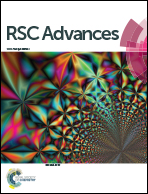Cucurbit[7]uril–tetraphenylethene host–guest system induced emission activity†
Abstract
A host–guest complex was successfully constructed from cucurbit[7]uril (Q[7]) and quaternary ammonium-modified tetraphenylethene derivative, 1,1,2,2-tetrakis{2-[2-(N,N,N-trimethylammonium)ethyoxyl]phenyl}-tetraphenylethene bromide (TAPET), and characterized by a wide range of techniques. This host–guest complex exhibits an AIE nature, resulting in strong fluorescence in dilute solution due to the restriction of the intramolecular rotation of the phenyl moieties of TAPET upon the addition of Q[7]. Moreover, addition of competitive guest 1-adamantanamine hydrochloride (Ada) leads to effective dissociation of the host–guest complex Q[7]–TATPE and turns the fluorescence emission off.
![Graphical abstract: Cucurbit[7]uril–tetraphenylethene host–guest system induced emission activity](/en/Image/Get?imageInfo.ImageType=GA&imageInfo.ImageIdentifier.ManuscriptID=C5RA24264A&imageInfo.ImageIdentifier.Year=2016)

 Please wait while we load your content...
Please wait while we load your content...